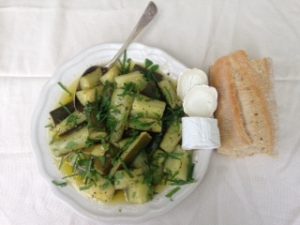In the greenhouse in spring I sowed lots and lots of courgettes. Really plenty, at least twelve in the hope of planting out about ten. I see you tutting and shaking your head but I am no newbie to the horrors of the courgette glut. I had a plan, and that was to grow many plants but to pick the fruits when they were tiny and sweet, and the flowers before that, hence there would – in theory – never be a glut.
It is now July and things have not entirely worked out as planned: there’s a surprise. The plants have grown well and a couple of weeks of rain- and life-induced allotment neglect and lo! I have a glut on my hands. I have to accept that courgettes will almost always produce a glut no matter what plans I make, and find something to do with them.

For my birthday this year a friend gave me Jane Grigson’s Vegetable Book, and I have been slowly working my way through it, vegetable by vegetable. But one of my favourite sections of the book is the appendix of dressings, many of which can be applied to all sorts of different vegetables, so whatever greenery happens to be weighing on your mind that particular day. One that I have taken a liking to is Greek dressing, ‘Lemonolatho’, and it has proved a rather fabulous way of dealing with courgettes in particular, but has also been very fine for broad beans, French beans, mange touts, baby potatoes and cauliflower. It requires a big pile of green vegetables, and quickly turns them into something delicious. Indeed the beauty of this Greek way of cooking them is that it really uses up a lot of courgettes, there’s really no point in making it with just one, so you almost want a glut. The vegetables are first boiled and then dressed, and the dish served later, at room temperature, which does good things for the flavours. After centuries of being reviled for boiling vegetables to mush we Brits are naturally a little wary of such things, but in this case the boiling simply makes the vegetables wonderfully receptive to soaking up the dressing. It’s really very lovely.
Start a pan of salted water boiling. Take four or five average sized courgettes and cut them into quarters across ways, and then again into quarters lengthways, then drop them into the water. Boil hard for several minutes then drain thoroughly. Return them to the pan (off the heat now) and squeeze over the juice of one whole lemon, then add 125ml good extra virgin olive oil, a teaspoon of dried mint and one crushed garlic clove. Stir then leave to sit for at least an hour, then stir again, sprinkle with some chopped fresh mint or dill, season with salt and pepper and serve. We’ve been having it as a side dish with a main course or with some feta cheese and baguette for lunch. You can leave it in the fridge and eat it as and when, but do bring it out 20 minutes before you want to eat so that it can get back up to room temperature.
Now that I have cleared out the biggies I can get back to my plan, of harvesting tiny and sweet baby courgettes still with the flower attached, and eating them raw or just lightly fried in butter and then a little salt sprinkled and lemon juice squeezed, of plucking and eating the flowers in salads or stuffed and baked. Until the next bout of neglect, that is, when lemonolatho will have to come to the rescue again.


